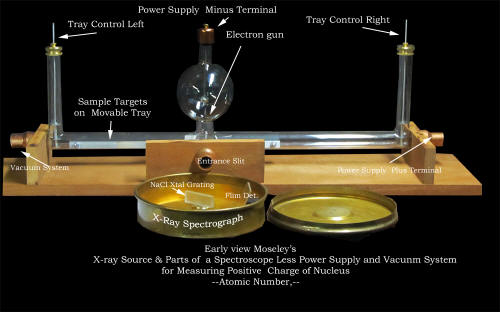From the book of Genesis 1.3, God said "let there be light"-- And God saw that the light was good".
A scientist said "give me some electrons I'll push them
around and they will give us light. Is this good?
Moseley pushing electrons around and studying the light that they
gave off with his light measuring scientific instrument **The spectroscope**saw
that it is was good. Good for his reputation. It wasn't it good
for those scientist's reputation's who had put elements
in the wrong box of the periodic table.
had not been using **
the spectroscope** to get the right answer. Was it good for
science's reputation showing that scientist could be
wrong? Was it good for for the human race who gained a
better life with the "right; or almost right answer?"
Moseley using the spectroscope gathered experimental data
in x-ray region of the spectrum which was used by Marie curie to
find bullets in soldiers bodies in the war I that would kill
Moseley who chose to fight in the war. which he used to correct
the mistakes others made in the placement of elements in the
Periodic table. He even predicted that scientist had been
missing elements in this table.
Planetary atom: Far more than the finding of empty holes
in a table of elements, Rutherford likened this kind of research as
stamp collecting. Moseley had used his spectroscopic data to
experimentally check, verify and select the interesting and then current
theoretical model offered to explain the nature of hydrogen
atomic spectra. The one he chose was the classic Bohr's picture of a planetary atom.
The theory in its simplest form fit hydrogen spectra which didn't last very long before it was
modified with a statistical approach. Still it was a
significant start.
Interesting planetary models were a hot topic in
Galileo's timeto some and certainly to some historians looking for connections.
Galileo 300 plus years ago was struggling with another . The model
of our solar system. He was gathering acceptable data using a
critical component of a spectroscope-- the telescope in his work. See
the last picture in a collage of two replicas of
Galileo telescope made into a spectroscope with prism.
"Note" Simply replacing the prism with a rock salt
grating one could use this spectroscope in Moseley experiment today.
Science was on a roll around 1900's +- 25 years
when Moseley' appeared on the scientific scene.
In Moseley's time scientist had made enormous improvements in
scientific instruments that expanded human's sense ,of seeing, hearing, feeling, etc.,
millions of times greater than nature provided. Example humans in
Moseley time had to get acquainted with very tiny and very large
things at the same time not only single atoms but parts of the atom, electrons, that
they could not see directly. The
Lorentz radius of the electron, 2.8 * 10 ^-13 cm.. The diameter of
the nucleus of
hydrogen proton was in the range of (1.75×10−15 m)
On the larger size they have had to start dealing with a universe billions of light years in radius.
All this with the new scientific instruments with the little valued
spectroscope leading the way.
Gaining perspective of the instruments that Moseley's
had available to work with were improvements in vacuum
technology (from the lighting world), high powered high voltage power
supplies (from the power distribute system to light the world), new
and more precise spectroscopes (from the analytical chemical world).
Added to this arsenal was the statistical mathematics from the
(business world).
The hottest scientific topics were the discoveries
of particles that atoms were made of electrons protons x-rays
and especially Marie curie's discovery of the enormous energy of
the nucleus and Einstein's E=mc^2 were keeping the world of science
flat out.
Moseley luck and borrowed gifts from many others was his
fascinated with high vacuum pumps , high voltage electron beams
and the x-ray grating spectroscopes.
For the latter if we go back in time one of the simplest examples
of humans relationship with spectroscopes, were nature's rainbows.
Humans could only view the sun's radiation using their natural senses.
They noted that
exposure to sun meant sunburns - later refer
to as ultraviolet radiation, the visible perception colors
light like the
rainbow, the sun's warmth later called infrared
radiation.
In our ,new, world
Moseley decided with help from his adviser to use a famous
senior scientist, Dr. Bohr, last gasping attempt to use classic
mathematical methods to build a formula to predict
the spectral light coming from very hot electron
temperature) hydrogen plasma. Moseley using this incorrect
(in the quantum mechanical sense) theory decided to count the number of individual protons in atoms
using man made rainbow generators (grating spectroscope made
using a large crystals grown from table salt as the light
dispersing element ). His goal was to correct the chemist's catalog of
elements and the pieces they are made of, appearing
(15,000 K)in the Period Table.
Again Quoting from Genesis
In the beginning "and darkness was upon of the deep'" and "and God
said" let there be light"- In science the rainbow spectroscope was
showing scientist the way to go both big and little with the
planetary model. |

.jpg)
.jpg)






